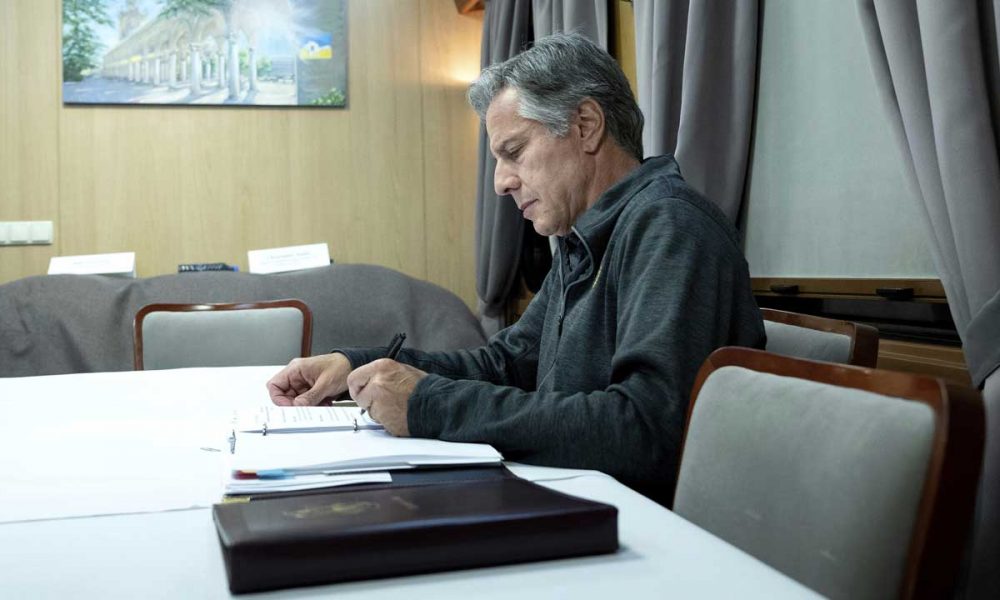Blinken Is Expected to Announce $1 Billion in New U.S. Funding for Ukraine During His Visit to Kyiv

KYIV, Ukraine — U.S. Secretary of State Anthony Blinken visited Ukraine’s capital Wednesday where he was expected to announce more than $1 billion in new American funding in a display of Washington’s unflagging support for Kyiv’s fight.
Blinken also aimed to assess Ukraine’s 3-month-old counteroffensive and signal continued U.S. backing as some Western allies express worries about Kyiv’s slow progress in driving out Russian forces after 18 months of war, according to U.S. officials.
“We want to make sure that Ukraine has what it needs, not only to succeed in the counteroffensive but has what it needs for the long-term, to make sure that it has a strong deterrent,” Blinken said during the visit. “We’re also determined to continue to work with our partners as they build and rebuild a strong economy, strong democracy.”
Blinken was set to pledge more than $1 billion in new U.S. funding, a senior State Department official said, speaking on condition of anonymity in order to discuss the announcement before it was made.
The money would be for “a range” of investments, the official said, without elaborating.
Other issues, including support for Ukraine’s war-torn economy were to be discussed, building on Blinken’s June announcement in London of $1.3 billion in aid to help Kyiv rebuild, with a focus on modernizing its energy network, which was bombarded by Russia last winter.
Kremlin spokesman Dmitry Peskov said that U.S. assistance to Ukraine “can’t influence the course of the special military operation” — Moscow’s euphemism for the war.
Blinken arrived in Kyiv for an overnight visit hours after Russia launched a missile attack on the city. He was expected to meet with President Volodymyr Zelenskyy and other top officials to discuss the ongoing counteroffensive and reconstruction efforts.
On the train journey to Kyiv, Blinken met with Danish Prime Minister Mette Frederiksen, also on an official visit, to discuss the war. Blinken thanked her for Denmark’s leadership in a coalition training Ukrainian pilots on F-16s and for promising to donate the fighter jets to Ukraine, according to State Department spokesperson Matthew Miller.
Washington officials said there will be discussions of alternative export routes for Ukrainian grain following Russia’s exit from the Black Sea Grain Initiative and its frequent bombardment of port facilities in the Odesa region, from which most grain is transported abroad.
Those alternatives may include new overland routes, or ships hugging coastlines to keep out of international waters where they could be targeted by Russia’s navy.
After arriving in Kyiv, Blinken laid a wreath at the city’s Berkovetske cemetery to commemorate members of the Ukrainian armed forces who lost their lives defending the country.
Blinken told Foreign Minister Dmytro Kuleba that the U.S. has “seen good progress in the counteroffensive. It’s very heartening.”
Meeting with Prime Minister Denys Shmyhal, Blinken said he was in Ukraine “to reaffirm our commitment to stand with you … to help ensure that you succeed militarily in dealing with the aggression, but also to stand with you to make sure that your efforts to build a strong economy and a strong democracy succeed.”
Shmyhal said Ukraine is grateful the money is coming in the form of grants, not loans that would drive it into debt.
Russia Fires Missiles at Kyiv Overnight
Overnight, Russia fired cruise missiles at Kyiv in its first aerial attack on the capital since Aug. 30, according to Serhii Popko, the head of Kyiv’s regional military administration.
Debris from a downed missile struck a business in Kyiv, causing a fire and damage. No casualties were reported.
In the Odesa region, one person was killed in a Russian missile and drone attack on the port of Izmail that damaged grain elevators, administrative buildings and agricultural enterprises, authorities said.
The trip was Blinken’s fourth visit to Ukraine since the war began, including one very brief excursion over the Polish-Ukrainian border in March 2022, just a month after the Russian invasion. But it will be the first time America’s top diplomat spends the night in the capital since he visited Kyiv in January 2022, before the invasion.
U.S. officials said Blinken’s decision to stay overnight was a signal of American support.
Shared priorities will be discussed with the state of Ukraine’s counteroffensive high on the agenda, a senior U.S. State Department official briefed reporters ahead of the trip, speaking on condition of anonymity in line with protocols.
Blinken’s visit comes after some of Ukraine’s allies have privately expressed concern that Ukrainian troops may fail to reach their objectives.
While the U.S. has been concerned by some day-to-day battlefield setbacks, U.S. officials said, they are still generally encouraged by Ukraine’s handling of the military situation, particularly its air defense capabilities in knocking down Russian drones aimed at Kyiv.
Blinken aims to get a view on how the counteroffensive is progressing and what kind of support is needed, including materials to break through dense Russian defenses with winter approaching. Air defense will also continue to be a priority, the official said.
Western analysts and military officials caution that the counteroffensive’s success is far from certain. Ridding Ukraine of entrenched, powerfully armed and skilled Russian troops could take years, they say.
Both sides will have to assess their supply shortages, with more battles of attrition likely over the winter. A long war could stretch deep into next year and beyond, according to experts.
Ukrainian forces are advancing without air cover, making their progress harder and slower, while Russia has launched its own push in the northeast to pin down Ukrainian forces and prevent them being redeployed in the south.
Ukraine has adapted its tactics in recent weeks, moving from attempts to bludgeon its way through Russian lines with Western-supplied armor to better-planned tactical strikes that make incremental gains, according to the Royal United Services Institute, a think tank.


